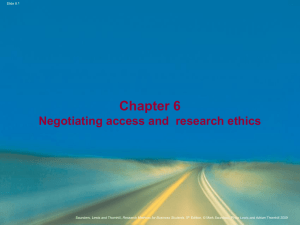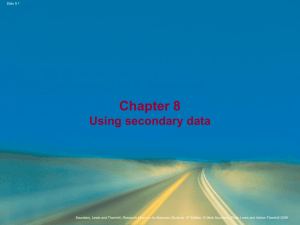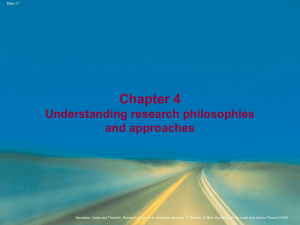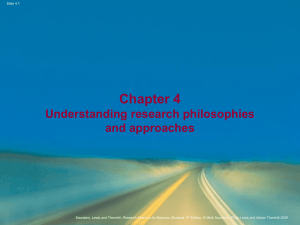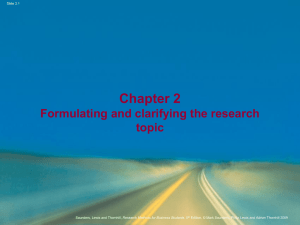Chapter 14 Writing and presenting your project report
advertisement
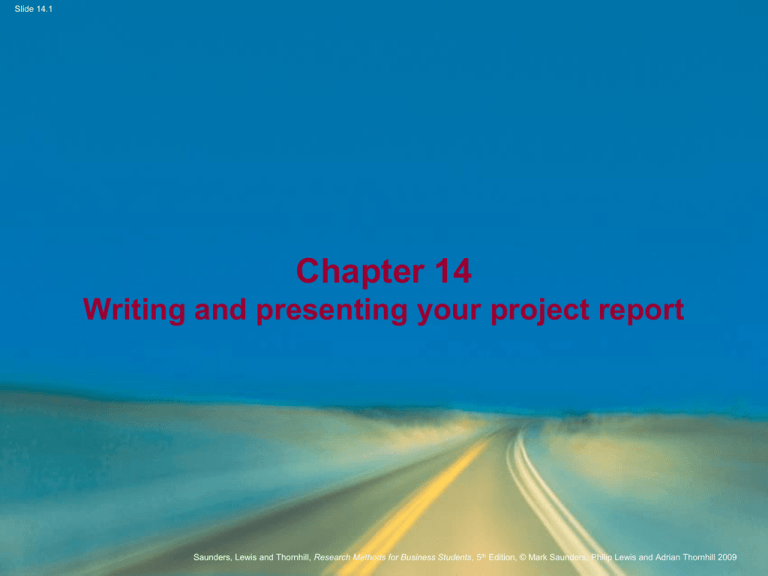
Slide 14.1 Chapter 14 Writing and presenting your project report Saunders, Lewis and Thornhill, Research Methods for Business Students, 5th Edition, © Mark Saunders, Philip Lewis and Adrian Thornhill 2009 Slide 14.2 Getting started with writing Practical hints • • • • • • • • Create time for your writing Write when your mind is fresh Find a regular writing place Set goals and achieve them Use word processing Generate a plan for the report Finish each writing session on a high point Get friends to read and comment on your work Saunders, Lewis and Thornhill, Research Methods for Business Students, 5th Edition, © Mark Saunders, Philip Lewis and Adrian Thornhill 2009 Slide 14.3 Structuring your research report Suggested structure • • • • • • • • • Abstract Introduction Literature review Method Results Discussion Conclusions References Appendices Saunders, Lewis and Thornhill, Research Methods for Business Students, 5th Edition, © Mark Saunders, Philip Lewis and Adrian Thornhill 2009 Slide 14.4 Writing for different audiences Key differences between an ‘Academic’ report and a ‘Consultancy’ or ‘Management’ report The academic report: • Tends to be longer • Will be marked and graded • Will contain contextual descriptions The consultancy report: • Has less focus on the development of theory • Contains recommendations relating to the organisation’s business Saunders, Lewis and Thornhill, Research Methods for Business Students, 5th Edition, © Mark Saunders, Philip Lewis and Adrian Thornhill 2009 Slide 14.5 Report structure (1) The abstract Four short paragraphs that answer the questions: 1. What were my research questions and why were they important? 2. How did I go about answering the research questions? 3. What did I find out in response to these questions? 4. What conclusions can be drawn? Adapted from Saunders et al. (2009) Saunders, Lewis and Thornhill, Research Methods for Business Students, 5th Edition, © Mark Saunders, Philip Lewis and Adrian Thornhill 2009 Slide 14.6 Report structure (2) Introduction - include • The research questions(s) and a clear statement of research objectives • Brief background and a guide to the storyline Literature review - purpose • To set your study in the wider context • To show how your study supplements existing work Saunders, Lewis and Thornhill, Research Methods for Business Students, 5th Edition, © Mark Saunders, Philip Lewis and Adrian Thornhill 2009 Slide 14.7 Report structure (3) Checklist Box 14.5 Complete the Checklist in Box 14.5 for points to include in your method chapter Developed from Robson (2002) Saunders, Lewis and Thornhill, Research Methods for Business Students, 5th Edition, © Mark Saunders, Philip Lewis and Adrian Thornhill 2009 Slide 14.8 Report structure (4) Results chapter(s) - purpose • To report the facts your research discovered • To support the facts with quotes from participants Discussion chapter- purpose • To interpret results and relate the findings to the original research goals and objectives • To indicate implications of the research Saunders, Lewis and Thornhill, Research Methods for Business Students, 5th Edition, © Mark Saunders, Philip Lewis and Adrian Thornhill 2009 Slide 14.9 Report structure (5) Using a matrix in the planning of the content for the results and conclusions chapters Saunders et al. (2009) Figure 14.1 Using a matrix in the planning of the content for the results and conclusions chapters Saunders, Lewis and Thornhill, Research Methods for Business Students, 5th Edition, © Mark Saunders, Philip Lewis and Adrian Thornhill 2009 Slide 14.10 Report structure (6) Conclusion chapter – purpose • • • • To answer the research question(s) To meet the research objectives To consider the findings To present any contributions to the topic displayed in the literature • To reflect on any implications for future research Saunders, Lewis and Thornhill, Research Methods for Business Students, 5th Edition, © Mark Saunders, Philip Lewis and Adrian Thornhill 2009 Slide 14.11 Report structure (7) References • Use a convention that is accepted by your university (e.g. Harvard, APA) • Cite all sources referred to in the text • Check all citations to prevent plagiarism Appendices • Include only essential supporting material • Include copies of interview schedules • Keep appendices to a minimum Saunders, Lewis and Thornhill, Research Methods for Business Students, 5th Edition, © Mark Saunders, Philip Lewis and Adrian Thornhill 2009 Slide 14.12 Organising the report content (2) Main points to consider • Choosing the title • Telling a clear story • Helping the reader byDividing your work Previewing and summarising chapters Using suitable tables and graphics Writing in a suitable style Saunders, Lewis and Thornhill, Research Methods for Business Students, 5th Edition, © Mark Saunders, Philip Lewis and Adrian Thornhill 2009 Slide 14.13 Writing style Key points: • Clarity and simplicity – avoid jargon • Checking grammar and spelling • Preserving anonymity • Regularly revising each draft Saunders, Lewis and Thornhill, Research Methods for Business Students, 5th Edition, © Mark Saunders, Philip Lewis and Adrian Thornhill 2009 Slide 14.14 Evaluating the first draft Checklist Box 14.11 Complete the Checklist in Box 14.11 to help you evaluate the first draft Saunders et al. (2009) Saunders, Lewis and Thornhill, Research Methods for Business Students, 5th Edition, © Mark Saunders, Philip Lewis and Adrian Thornhill 2009 Slide 14.15 Oral presentation Three key stages: • Planning and preparation • Use of visual aids • Presenting Saunders, Lewis and Thornhill, Research Methods for Business Students, 5th Edition, © Mark Saunders, Philip Lewis and Adrian Thornhill 2009 Slide 14.16 Summary: Chapter 14 • Writing is a creative process and a powerful way to clarifying your thinking • A project report needs a clear structure that helps to develop the storyline • All the information should be readily accessible to the reader Saunders, Lewis and Thornhill, Research Methods for Business Students, 5th Edition, © Mark Saunders, Philip Lewis and Adrian Thornhill 2009 Slide 14.17 Summary: Chapter 14 • Use a clear writing style free and check for spelling and grammatical errors • Be prepared to rewrite the first draft several times • Remember to check the assessment criteria Saunders, Lewis and Thornhill, Research Methods for Business Students, 5th Edition, © Mark Saunders, Philip Lewis and Adrian Thornhill 2009 Slide 14.18 Summary: Chapter 14 • Failing to prepare for your presentation is preparing to fail • Visual aids help the audience understand your presentation Remember to – • Tell them what you're going to say • Say it • Tell them what you said Saunders, Lewis and Thornhill, Research Methods for Business Students, 5th Edition, © Mark Saunders, Philip Lewis and Adrian Thornhill 2009

